Michael Bond: How Paddington Bear went from darkest Peru to London's Olympic Games
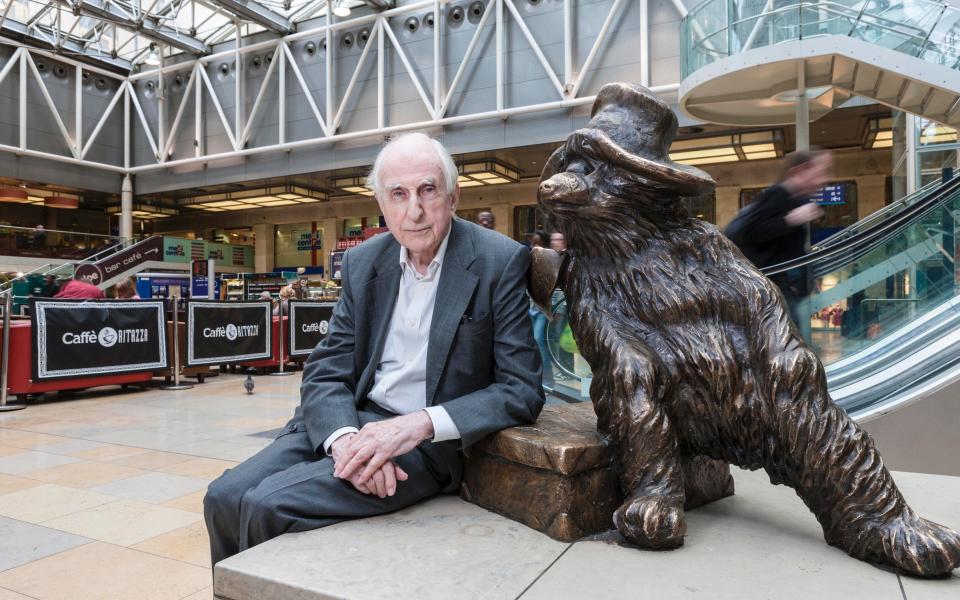
In a 2012 interview with the Telegraph, Michael Bond - then 86 - explained why he had no plans to give up writing. After his sad death, aged 91, following a short illness, we republish it, here
Michael Bond is national treasure. I know this because as the 86-year-old was trying to pose for our photographer next to the statue of his greatest creation, Paddington Bear, in Paddington station, he was mobbed by rush-hour commuters.
A crowd of about 30 Paddington Bear fans (mainly adults, it has to be said) encircled the statue, all clamouring to speak to him. “Is that really Michael Bond?” gushed a woman in her thirties who’d spotted him while paying at the adjacent Yo! Sushi. “I’m just going to tell him quickly how much I love Paddington.”
Dragging an enormous suitcase behind her, she darts in front of the lens, closely followed by a man in black tie, and a woman with a pushchair. Bond, who has presumably experienced similar episodes in the past, apologetically halts the photographer and turns shyly to the queue of well-wishers, which by now includes a Chinese couple and the station manager.
Earlier that day over tea at his home in Maida Vale, Bond warned me that Paddington has a habit of stealing the limelight. “Once on a long-haul flight I was invited to visit the cockpit but it was Paddington the pilot wanted to meet, not me,” he says, his voice hoarse from a morning of radio interviews about his new book, Paddington Races Ahead, which is 13th in the series.
Bond was 28 when he first wrote about Paddington, a little brown bear from darkest Peru, who is sent to London when his guardian Aunt Lucy moves to the Home for Retired Bears in Lima. He arrives at Paddington station with a jar of marmalade and a label round his neck saying “Please look after this bear” and is discovered by kindly Mr and Mrs Brown, who take him back to their home in Windsor Gardens and adopt him into their family, to the delight of their children Johnathan and Judy.
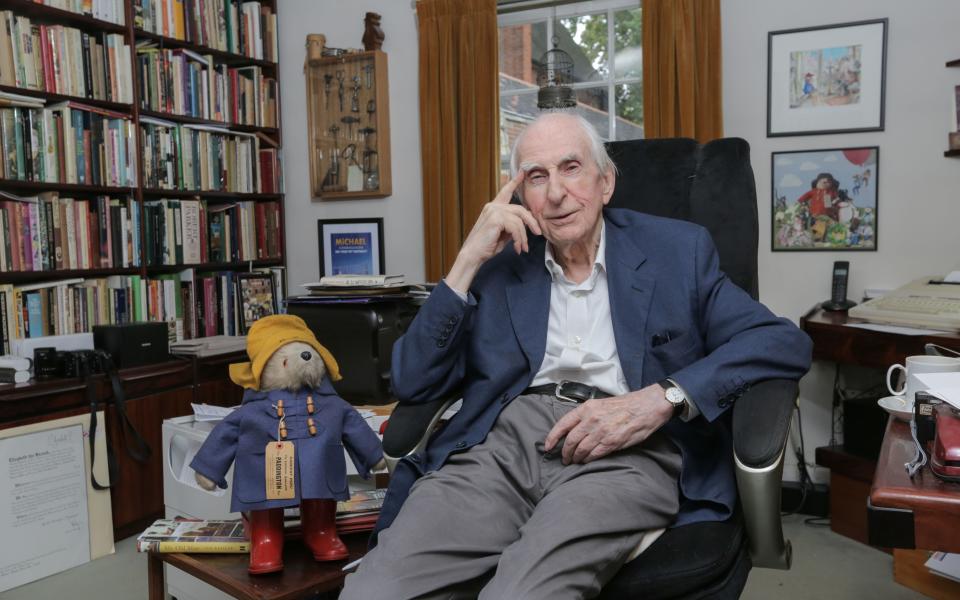
Even Mrs Bird, the Brown’s formidable housekeeper, cannot help but warm to Paddington who has impeccable manners yet a talent for trouble. He’s been cherished by readers ever since the first book was published in 1958: more than 40 million copies of the books have sold; there’s been an award-winning television series; and there’s talk of a film featuring a computer-generated Paddington.
According to Bond, Paddington was “strangely real” to him from the start and is now a part of him. “I often find myself asking what Paddington would think or say. When I write him into an impossible scrape, I go to sleep confident that I will know how to get him out of it when I wake up the following morning.”
Extracting Paddington from trouble has always been the most difficult part of writing the books and is proving increasingly tricky, he admits. “You’ve got to find new ways of doing it every time. Sometimes I look at what I’ve written and worry that I might have written it before.”
In this latest adventure Paddington is mistaken for a Peruvian hurdler competing at the 2012 Olympics and tries to board a London bus using a pair of fresh oysters – rather than an Oyster Card. “Paddington moves with the times, just as I do,” Bond says, gesturing towards the two Apple Macs that dominate his study. He’s even downloaded the Paddington iPhone app on to his phone (a £3.99 program that enables fans to make recordings of themselves reading a Paddington story, and take photographs of themselves with a Paddington Bear frame). “I wasn’t bothered about it when Harper Collins suggested making the app but it’s actually quite tasteful,” he says.
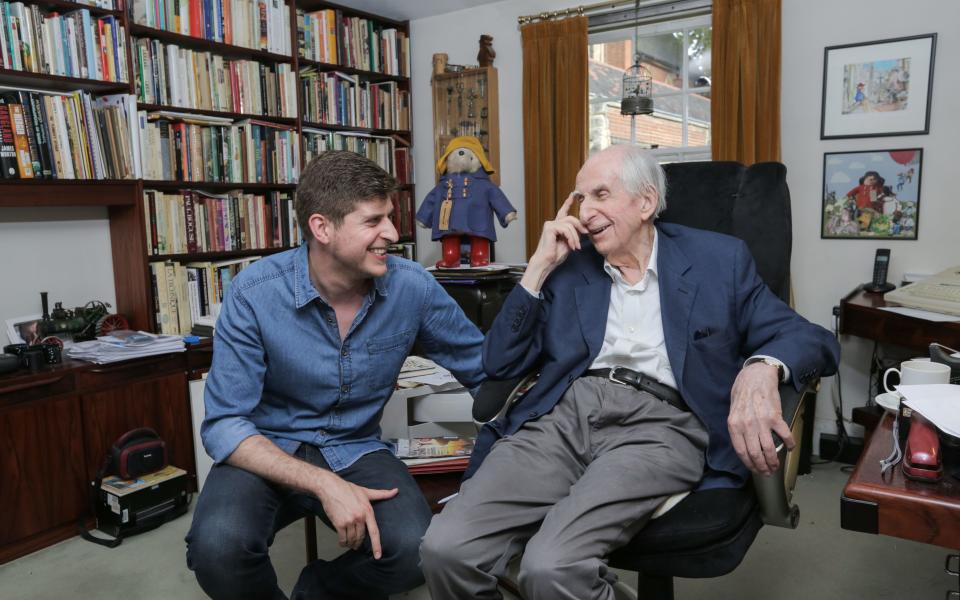
Bond, who lives with his second wife Sue, a retired literary agent, and has two adult children, Anthony and Karen from his first marriage, has more than 100 children’s books to his name – and no plans to retire from writing. He insists however, that he didn’t set out to be a children’s author. “If you’d told me that I’d be sitting here now giving interviews I’d have thought you were mad,” he says. But you could say that a childhood spent reading cartoon strips such as Billy Bunter laid the groundwork for it. “They taught me that repetition is key in comic writing,” he says. “Billy Bunter was always expecting a postal order but you knew he wasn’t going to get it.”
In 1941, in the midst of the Second World War, Bond, then aged 15, got a job with the BBC in Caversham near Reading, switching the radio transmitters on in the morning and off at night. He was in an office at the top of the building when it was hit during an air raid. “I’m lucky to be here. The first person I came across was a girl with her legs blown off,” he recalls. “And the second was an old man holding his false teeth.”
After the war Bond joined the BBC monitoring service, which translated radio programmes from all over the world (for intelligence purposes), and then switched to the BBC’s children’s television department in 1956 where he worked up the ranks to cameraman on the first series of Blue Peter.
In his spare time he dabbled with creative writing. “I had a short story published in 1945 in the magazine London Opinion but I could have papered my study in rejection letters,” he says.
Then one day in 1954 he was sitting in front of his typewriter in his flat in west London with a blank piece of paper and nothing to write, when a small bear on the mantle piece caught his eye. “I’d bought it for my first wife and I’d called it Paddington after the station I commuted from. I thought it was a proper-sounding name,” he explains.
He began to wonder – as you do – how a real bear from Peru might feel if it arrived at Paddington station, and dashed out a few lines. “No one went to Peru in those days so it seemed very dark,” explains Bond. Ten days later he’d finished his first book, A Bear Called Paddington. “Paddington was the first character-driven story I’d ever written and for some reason he came alive,” he says.
This was helped by the fact that, remarkably, none of the other characters seem to find it in the slightest bit odd to encounter a talking bear sporting a duffel coat. Bond claims always to have found bears strangely human. “I think the fact that they can stand on their back legs humanises them,” he says. “But the great advantage of Paddington is that he’s 'humanised’ but not a human, which means he gets away with things.”
Bond based the human characters – except Mr Curry, the Brown’s busybody neighbour – on people he either knew or had encountered. Mr and Mrs Brown, for example, are loosely based on his parents. “My father, a civil servant, would have been very worried as to whether he’d be breaking the law by taking Paddington home,” Bond says. Traces of Bond’s father can also be found in Paddington. “He was a polite man who always tipped his hat and never wore a bathing costume in the sea; he’d just roll his trousers up. But if he came against something he thought was wrong he did stick his feet in, just like Paddington.”
The disparate cast appeals to all generations. “If adults are going to read to their children they’ve got to love the books themselves,” Bond says. “If you’re laughing, your children will want to know why. If you’re bored, they’ll want you to stop reading.”
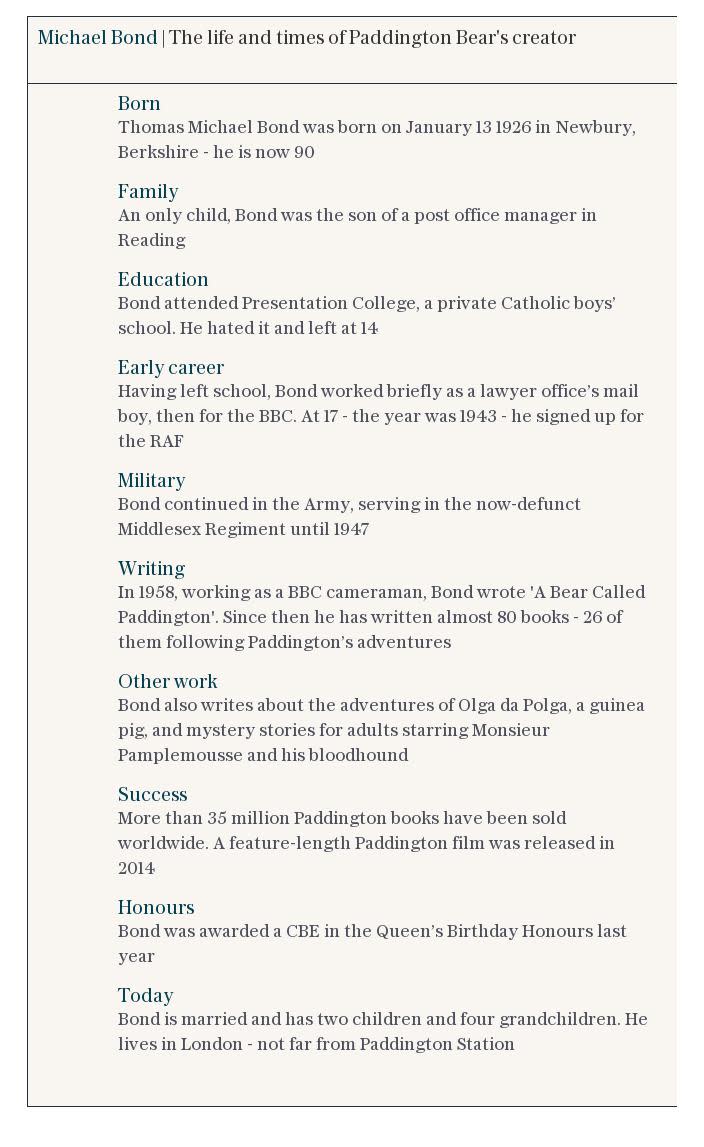
But the stories also attract those without children: a terminally ill nun once wrote to Bond thanking him for the strength she had found in Paddington; after the first book was published he received a letter praising his approach to “the colour question”. Bond found this baffling. He had never set out to address serious issues such as that. “It hadn’t occurred to me that I had an attitude,” he says. “In those days the only coloured people I saw were Americans.” But subsequent correspondence from fans over the years has proved to him that Paddington, as an immigrant from Peru, and his best friend Mr Gruber, a refugee from Germany, are figures that many identify with. “I based Mr Gruber on my literary agent Harvey Unna who fled Germany before the war,” Bond says. “He used to tell me that people never recognise themselves in books and he was right; he never realised he was Mr Gruber.”
Paddington made his first television appearance in a BBC series in 1975 as a two-dimensional figure with the other characters as cardboard cut outs. “It was way ahead of its time,” says Bond, who wrote 56 scripts for the series. “It was recently voted the best children’s animated series ever.”
In Paddington Races Ahead, Paddington insists he doesn’t want to be famous but in real life, with seven million people watching him on television, he had no choice. Fiercely protective, Bond tried his best to impose standards on the Paddington merchandise the film company – and practically every toy manufacturer in Britain – were pushing to produce.
The original Paddington figure made in 1972 by Gabrielle Designs, a small business run by Shirley Clarkson (Jeremy Clarkson’s mother) captured the character and charm of the bear in his duffel coat and Dunlop wellies, but after the television series Bond was inundated with licence requests to make much less salubrious items: a furry bin with Paddington’s head as the lid was a big no, for example, while Paddington printed loo paper was out of the question. “I’d go by what Paddington would have thought,” Bond says. “It seemed the most sensible way of deciding.”
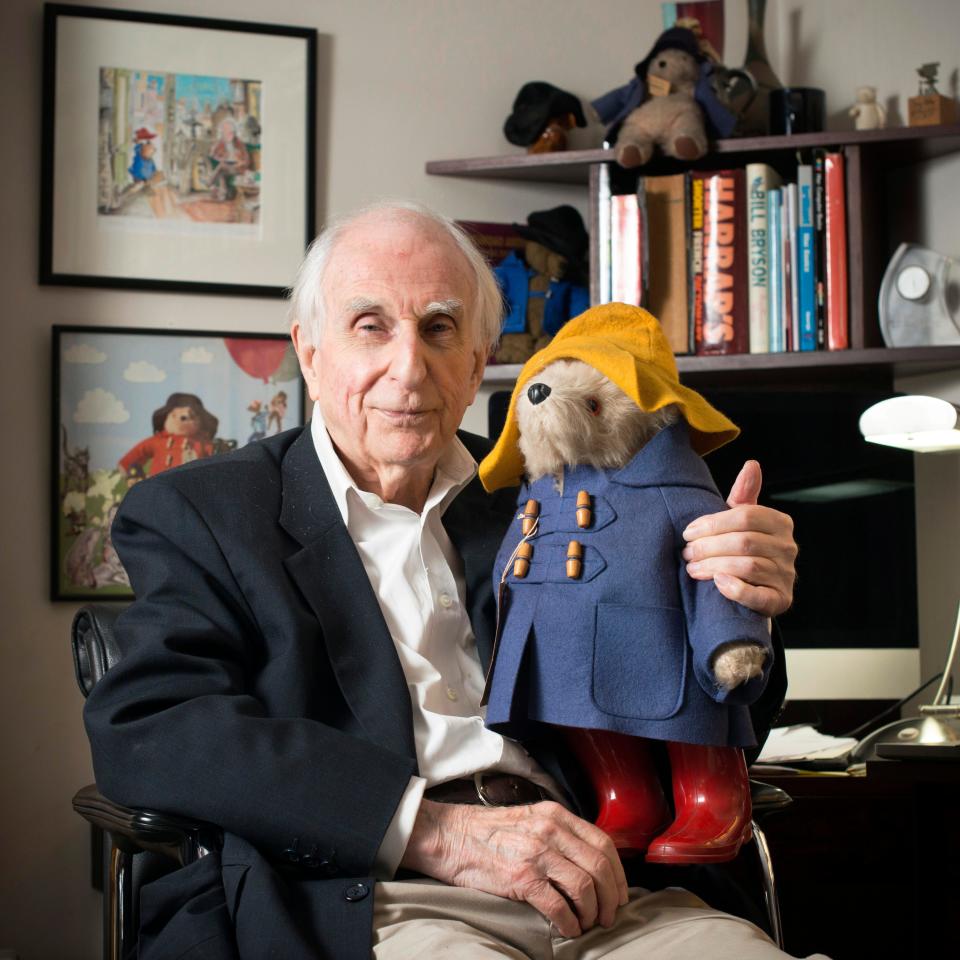
In the end he hired a rights lawyer to deal with the licensing. Soon after his daughter Karen left her job to run his office, leaving Bond free to write: not just more Paddington stories but picture books, television scripts and a French detective series, Monsieur Pamplemousse. The idea for the opening chapter of the latest Paddington book came to him last spring when he was sowing seeds in his garden.
“I asked myself – as usual – what Paddington would do in my position and I guessed that he’d rush outside the following morning to see if there’d been any growth,” he says. “He’s such an optimist.”
If the enthusiasm of fans at today’s photoshoot is anything to go by, Bond could be forgiven for wanting to keep his distance from Paddington occasionally. Does he ever get sick of him? “Yes. Whenever I finish a book I vow never to write another,” he says emphatically.
But in the end, he always returns to Paddington; he’s already jotted down an idea for a new story. “I can’t be angry with him. He always creates so much good will. I wish there was more of Paddington in me,” he sighs. There was one time, however, when Bond would have preferred Paddington to stay at home: the day he dropped Karen off at Exeter University for her first term. “In the car park there were girls getting out of their parents’ cars with Paddington Bears in their arms,” says Bond.
Poor Karen hadn’t been able to go to a party when she was younger without someone asking her about him and now here he was again. “I was surprised to learn that the toys were popular with young girls who, apparently, wanted a father figure to watch over them in their bedrooms at university,” Bond explains.
Now what would Paddington think about that?

 Yahoo Sport
Yahoo Sport 





































